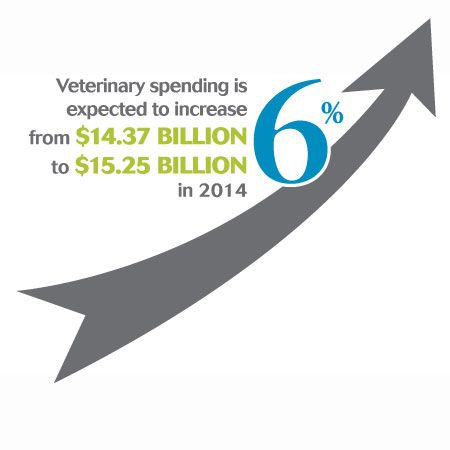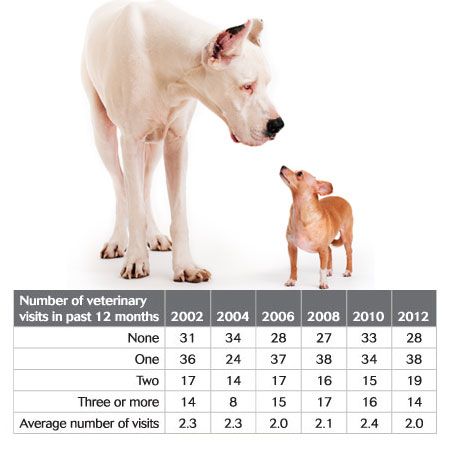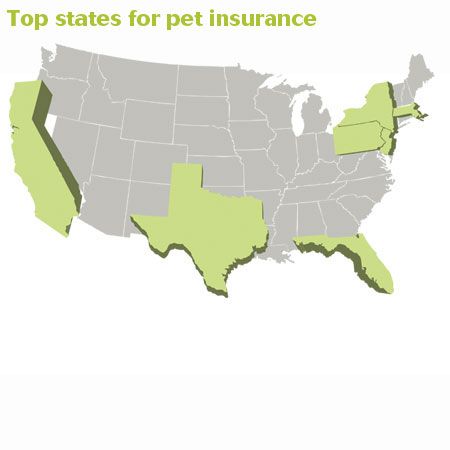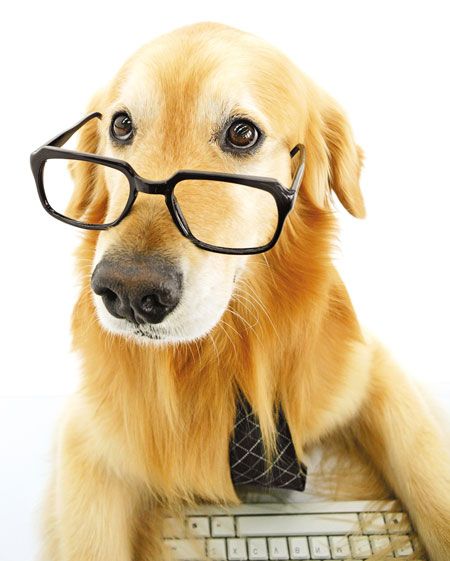Visits may be down, but veterinary spending is going up
Pet expenditures exceed expectations in 2013; forecasters expect more growth in 2014.
Next >

Despite a slow financial start to 2014, veterinarians will be happy to know the American Pet Products Association (APPA) says spending on veterinary care is rising. The category showed significant growth in 2013, with pet owners spending $14.37 billion on veterinary care-up 5 percent over 2012. Plus, the APPA estimates that veterinary spending will reach $15.25 billion this year, a 6 percent increase from 2013.
While spending on veterinary care may be rising, veterinary visits are at best flat. Though the average number of dog visits did drop from 2.4 in 2010 to 2.0 to 2012.

According to the Bayer Veterinary Care Usage Study, cats see a veterinarian about half as often as dogs. And, as investigated in the recent dvm360 Leadership Challenge “Cat care in crisis,” one of the primary reasons why is the misconception that cats don't need regular care.

In conjunction with this finding, the APPA report states that 47 percent of cat owners list “convenience, easy to maintain” as a benefit to cat ownership. Cost is an obstacle to regular cat care, and according to the APPA report, cat owners spend far less on their pets.

Top costs and veterinary spending
The APPA expects food sales to reach an all-time high of $22.62 billion in 2014. “Both food and veterinary care are strongly influenced by consumers' growing interest in improved healthcare for their pets,” says Bob Vetere, president and CEO of the APPA.

This growing interest may also be reflected in the demand for electronic tracking and pet insurance. The APPA found that microchips are more prevalent since its last survey, showing that 35 percent of dogs and 18 percent of cats have been chipped. “Pet owners (particularly those with companion pets) are emotionally attached to their pets and are willing to invest in tracking devices to ensure they can find their pet in the event the pet goes missing,” the APPA executive report states. “In addition, owners with more expensive pets may look to electronic tracking devices as a means to protect their investment.” The report notes that the increase may also be a result of pets obtained from a shelter where a tracking device was already implanted prior to adoption.
The APPA report's executive summary says pet health insurance has shown a slow but steady gain during the past decade. The organization is projecting that total spending on pet insurance will grow from the anticipated $650 million this year to more than $870 million by 2015.
Since 2010, the percentage of insured dogs has risen from 4 to 5 percent. The percentage of cats insured has jumped from 1 to 3 percent. The APPA says that dog owners with insurance paid between $250 and $499 a year in premiums on average, whereas most cat owners with insurance paid less than $250.

Pets Best, ASPCA Pet Health Insurance, Embrace, Veterinary Pet Insurance (VPI) and Trupanion provided dvm360 their top five states for pet insurance. California, New York, Texas, Florida, New Jersey, Massachusetts and Pennsylvania were clear winners for each of the companies. Results aligned with population for the most part, but ironically did not align with a survey conducted in 2012 by the American Veterinary Medical Association (AVMA) that revealed the top pet-owning states. States included amongst the lowest were California with 52.9 percent, New Jersey with 50.7 percent, New York with 50.6 percent and Massachusetts with 50.4 percent. Vermont had the most pet-owning households with 70.8 percent.
Good news
While more and more spending is done online, the APPA says most people still rely on their veterinarians for information about their pet. Specifically, 67 percent of dog owners and 53 percent of cat owners rely on their veterinarians, while 43 percent of dog owners and 41 percent of cat owners get information from the Internet.

Overall, and not surprisingly, spending in the pet industry continues to exceed expectations. The APPA expects continued growth in 2014 as well. The association estimates overall pet spending for 2014 at $58.51 billion, a 4.9 percent increase over 2013.
The largest percentage of growth in 2013 was seen in pet services such as grooming, training, boarding and other luxury services. The category is on track to do the same this year. “People are pampering their pets more than ever and manufacturers and businesses are offering new products, services and opportunities to meet their needs and wants-from interactive and innovative toys to dog walking, doggy daycare and pet-friendly hotels, restaurants and airlines,” Vetere says.